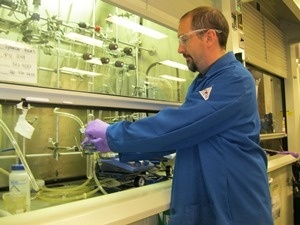Bill Singh is no stranger to safety at Berkeley Lab. In his 6 years here, he’s already received two Hero Cards — which are given out for demonstrating good safety behavior — and a Safety Spot Award. And now, Bill can add “raffle winner” to his list of safety-culture achievements.
A few months back, Singh, a senior recruiter in Human Resources, spotted slip hazards on a walkway near Building 90. “Leaf-blowers had blown foliage onto the hilly stairway leading from Building 90 to Building 55,” he says. This made for a slippery situation, so Bill took action and cleared the branches off the walkway so that others could walk safely. Robert Rodriguez, a fellow senior recruiter in HR, happened to see Bill’s efforts to prevent a slip-and-fall injury, and promptly handed over a Hero Card.
Senior recruiter, HR
Hero Cards are a way for Lab workers to thank one another for using safety common sense, and for looking out for fellow employees. The size of a credit card, they are passed along when one employee catches another in the act of doing the right thing. And they’re not just a thank-you for a job well done; winners receive a “Safety Is Elemental” pin and can become eligible for a quarterly raffle drawing, with a cash prize.Bill became a raffle winner when his card was recently drawn for the $50 prize. Following instructions on the card, he had registered it at the Hero Card Program website, which made him eligible for the raffle.
Bill is matter-of-fact but serious about Berkeley Lab safety: “The importance of safety is visualized daily, when you start looking for hazards and realizing the things that can cause injury or illness.” When you work at the Lab, he says, “It becomes second nature. You see floor mats flipped over, it becomes a habit to flip them back. You see branches in a walkway, it’s become a habit to move them so nobody will trip.”
And Bill believes in paying it forward. The card didn’t linger in his possession for long. When he one day was chatting with fellow employees, he stepped back, not noticing he was close to a 2-foot drop behind him. He was quickly warned about the situation by colleague Blanca Bocobo, who then became the next owner of the Hero Card. And so it goes.
Another $50 raffle winner was Helen Budworth of the Life Sciences Division. She verified that cryostat users were trained and the cryostat service technician was working with a valid SJHA.
Do you have a Hero Card that’s gathering dust? Pass it along! Carry a card with you, and when you notice a fellow Lab worker doing the right thing for safety, thank them with a Hero Card. Would you like a supply of Hero Cards to give out? Click here. More than 250 Hero Cards have been given out so far.
Sometimes the barrier to a healthy safety culture may not be in the lab but in your assumptions.
Prof. Monte Helm had some trepidation about doing research at Pacific Northwest National Laboratory (PNNL). He feared a “government-run laboratory with inflexible rules instituted by someone with no experience working with dangerous compounds,” he says. But Helm, a chemistry professor at Fort Lewis College in Durango, Colorado, had an entirely different experience at PNNL. And he brought that inspiration back to enhance his own laboratory.
“It was the opposite of what I expected. PNNL's implementation of safety rules helped our research move forward in a safe and effective way. My experiences at PNNL led me to consider how I could implement similar safety rules and procedures at my Fort Lewis lab." Helm had suspected that his students did not follow rigorous safety procedures. After his national lab experience, he determined to change that.
Helm presented his observations recently to postdocs at PNNL, which published his findings in a Lessons Learned. Among the changes he says he brought back to his research group:
- The determination to improve their safety culture. When in the lab, students are now required to:
- Use PPE: eye protection, lab coats, gloves
- Work in fume hoods with the sashes set correctly
- Follow standard lab rules.
- Remind others if they are not following safety rules.
Helm, now a senior scientist and deputy director of the Center for Molecular Electrocatalysis at PNNL’s Physical Sciences Laboratory, cites other lessons learned from his national laboratory experience:
- Top-down. In any lab, safety culture starts with the principal investigator, who must:
- Remove obstacles to safe practices by making safety equipment readily available.
- Inculcate the importance of safety culture into lab workers’ — and students’ — behavior. At his college lab, Helm says, “only about 10%” of postdocs arrive with proper safety culture awareness.
- Supervise. Helm’s PNNL EHS representative shadowed him. “She was invested in keeping the lab safe, not inhibiting my progress. It’s important to know somebody is watching out for you.”
- Responsibility. Safety violations can have great impact and affect a wide range of people. At a university, researchers may feel they have more freedom to experiment without restrictive safety rules, Helm says. But in his national lab experience, safety rules enabled successful research by reducing risks.
- National lab groups work together closely, watching out for one another.
- Safety culture creates pride in one’s work.
- Safety promotes good science.
- A strong safety culture protects the institution’s reputation.
- Meetings. Safety meetings reinforce protocols.
- At PNNL, Helm’s group met monthly to discuss safety and recent incidents. At the university, however, “we didn’t sit down and talk about safety or discuss why it’s important.”
- When accidents happen, they are discussed in meetings. The broader worry at the national lab is, “How can we minimize risk to researchers and create a reputation for doing work safely?”
Note: From PNNL Lessons Learned

